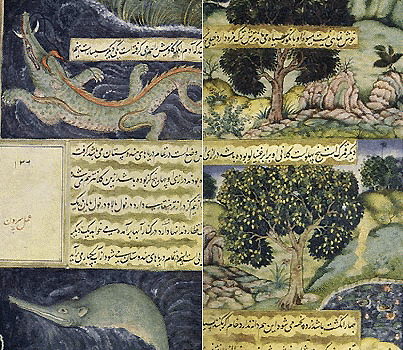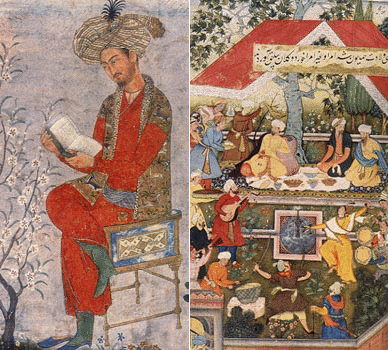
|
|
|
|
The Mughal Influence on Vaisnavism, Part 6
BY: SUN STAFF

Illustrations from Babur-namah Apr 17, 2010, CANADA (SUN) — A serial presentation of the Mughal effect on Vaisnava society. In yesterday's segment we mentioned the fact that the first Mughal Emperor in India, Babur, held such a short period of rule (1526 to 1530 A.D.) that we find no real mark left on Indian art as a result of his court's influence. He was followed by Hamayun, then Akbar, under whose reign a great impact was made on India's devotional arts. Even so, the footprint of Babur's rule can be traced to later day Vaisnava paintings, some of which emulate the Mughal style first presented in the Babur-namah, the autobiography of Babur.
Babur-namah is a collection of memoirs of the Emperor Zahir ud-Din Mohammad Babur, the great-great-great-grandson of Timur. It was originally written in the Chagatai language, known as "Turki", written prior to his death in 1530 A.D. Later, during Akbar's reign, the Babur-namah was translated to classical Persian. Around 1590 A.D., a series of paintings were done as illustrations for the book. Like the examples from the Chunar Ragamala given in yesterday's segment, the illustrations done for Babur-namah allow us to see how the Mughal influence traveled from Babur's court to the realm of Vaisnava art. The images above and below, illustrations from Babur-namah, are painted in a style that will be familiar to many readers, because we periodically see paintings of Sri Krsna and His associates and pastimes done in similar style. In fact, this school of painting originated long before Babur was born. Its roots are found in the Timurides School, a style of miniature paintings developed in the Persian cities of Herat (today's western Afghanistan), Samarkand (Uzbekistan), Tebriz (Azerbaijan), and Shiraz (Iran).

Illustrations from Babur-namah This very distinct Timurides style is easily recognized by the rendition of rocks and landscape. As shown in both sets of images above, the artists depicted rocks and hillsides in very soft, flowing shapes, stacked vertically or layered together with rounded edges. This very same style is evident in early Mughal paintings with Vaisnava content, including illustrations from the Harivamsa, or Harivamsa Purana a Sanskrit text documenting the life of Sri Krsna as a cowherd in Vrindavan. So here we have another example of crossover from the Islamic Mughal arts to Vaisnava paintings. The Harivamsa, which is comprised of 16,374 verses, is considered to be an appendix or supplement to the Mahabharata. Its authorship is ascribed to Sri Krishna Dvaipayana Veda Vyasa, dated sometime after his Mahabharata.

Sri Krsna Lifting Govardhana In the painting above, a folio illustration from Harivamsa, we can clearly see how the early Mughal style of painting found in the Babur-namah was also used in the Harivamsa illustrations. In fact, this scene of Krsna holding Govardhan Hill gives us an excellent context for making that comparison, since the whole of Govardhan is made of rocks. Of course, that is not the only point of comparison we can make. In the image below we find another illustration from Harivamsa this time depicting Lord Balarama's pastimes with the demon Dhenuka. While there are no rocks in this painting, we can see the likeness between the painted figures, both persons and animals. Taken on its own, the Dhenukasura painting might easily been viewed as a traditional, later period Vaisnava painting, with no Mughal influence. Seen complete in its decorative frame, however, there is no question of the Mughal influence, given that the patterned flowers are entirely Persian in style.

Balarama Kills Dhenukasura Another important aspect of the crossover artistic styles demonstrated by the Harivamsa paintings is what they represent in terms of Akbar's mood. Akbar's reign (1556–1605) began 30 years after his Mughal predecessors, and continued for another 49 years. In total, this represents about 60% of the 132-year span of Mughal rule in India. By Akbar's era, there was a great effort underway to repair the social damage done by the Mughal invasion. As part of Akbar's policy of generating reconciliation between the Muslims and Hindus, he undertook a program to translate many of the Hindu classics into the Persian language. These volumes were illustrated by his court artists, and the above illustrations from Harivamsa were part of that effort. Although the Emperor Akbar made a great effort to sway the sentiments of his Hindu subjects, history shows that the Vaisnavas didn't succumb to the Islamic religious sentiment. They never swayed in their program of taking shelter of Sri Krsna, just as the residents of Braj took shelter of Govardhan Hill against Indra's rains.

Emperor Babur and his court
| |